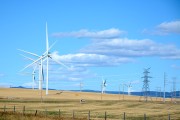Whether it is the Keystone XL pipeline, the Northern Gateway pipeline or securing an export market in China, the oil sands have dominated much of the recent energy discussions in Canada.
What might surprise many is that Canada is quietly emerging as a renewable energy leader, but it will take the same political focus currently being put toward oilsands to ensure we retain and grow the jobs that are being created in the country's emerging clean energy sector.
In 2011 Canada was sixth in the world in wind energy installations, and as recently as November 2011, Ernst & Young ranked Canada as the eighth-most attractive country in the world for renewable energy investment, ahead of some traditional leaders including Denmark, Spain and Japan.
Despite having fewer than 35 million people, Canada has the sixth-largest electricity system on the planet, behind only China, the United States, Russia, Japan and Germany. Given the size of our electricity system, perhaps it shouldn't come as a surprise that Canada ought to be one of the leading markets for renewable electricity.
Much of this growth was kicked off a decade ago when the Chrétien government adopted Canada's first wind power incentive, a policy that had been supported by both environmental organizations and major energy companies. The Harper government extended and expanded this initiative in 2006. While the federal government is now scaling back its support for renewable energy and energy efficiency, many provinces have picked up the pace.
Ontario and Quebec have the largest absolute renewable energy targets in Canada, while Prince Edward Island has some of the best wind energy targets per capita in the world. Historically a coal-fired province, Nova Scotia has committed to reduce its coal-fired power by almost half in the next 10 years and to get 40 per cent of its power from renewable sources by 2020.
On the other hand, Alberta and Saskatchewan — two provinces that burn coal for the majority of their electricity — currently have no framework for replacing coal-fired power with renewable sources.
The varying degrees of ambition and the long-term stability of provincial policies leaves Canada and potential investors without a clear national strategy for clean energy development.
While electricity is a provincial jurisdiction, Canada needs a more co-ordinated approach to clean energy development nationally. Some provinces have made great strides alone, but they can accomplish far more by working together.
For instance, hydro systems are great partners for wind and solar power. Hydro plants can act like a big battery, storing water in their reservoirs or even pumping it up when it is very sunny or very windy and the demand is low, and then releasing water to generate power during high-demand periods. While some provinces are starting to take advantage of this synergy, there is little talk of regional co-operation to do so. Yet all of the provinces that remain dependent on coal-fired power also have excellent underused wind regimes and are located next-door to provinces with large hydro capacity.
A focused effort on clean energy development would not only help to identify and support such strategic provincial interconnections, but would also look for ways to create a level playing field with highly polluting sources of energy such as placing a meaningful price on carbon emissions. A co-ordinated national effort would also accelerate key areas for technological innovation and integration of renewable energy.
Despite the recession, total global investment in renewable energy in 2010 exceeded $250-billion, an increase of more than 30 per cent from the record-breaking investments the previous year.
While Canada is currently a good place for clean energy investments, the global industry is expanding rapidly, and if we do not have our prime minister, our premiers and our energy ministers supporting renewable energy with the same attention that is being given to markets and pipelines for fossil fuels, Canada may find itself losing ground and jobs in what is projected to be a $3-$5-trillion industry in 2020.
In his State of the Union address last month, U.S. President Barack Obama recognized the significance of the clean energy opportunity, stating: "I will not walk away from the promise of clean energy. . .I will not cede the wind or solar or battery industry to China or Germany because we refuse to make the same commitment here."
Like our neighbours to the south, Canada has the resources and expertise to become a serious player in the growing clean energy market — but that transformation will not happen by accident.
Given Canada's vast and diverse renewable energy sources, one of the world's largest electricity systems could be the first to be 100 per cent clean and renewable. The size of the economic prize is huge and would have lasting benefits, should Canada choose to embrace this opportunity.






